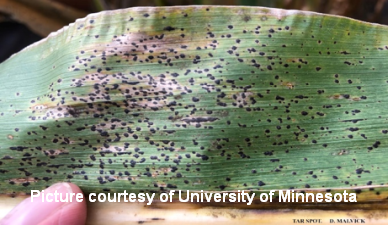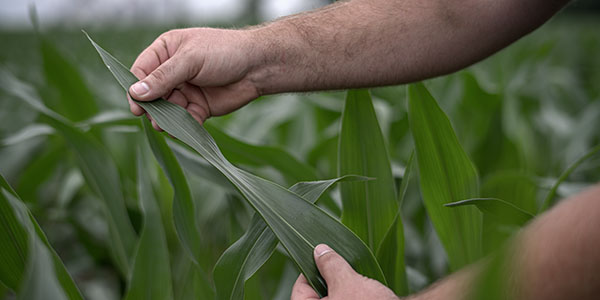AGRONOMICSUPPORT
YOU CAN TAKETO THE FIELD
Corn Fungicide - Learning from 2019 for 2020
 What a year 2019 was, and still is for several trying to finish harvest! It’s one most of us would like to put in the review mirror. There’s always something we can learn though, and often it’s the really tough years when we can learn the most and try to use it in the future.
What a year 2019 was, and still is for several trying to finish harvest! It’s one most of us would like to put in the review mirror. There’s always something we can learn though, and often it’s the really tough years when we can learn the most and try to use it in the future.
So, what did we see in 2019 as far as fungicide use and response? As is the norm in agriculture - it just depends. Generally, the corn that was fortunate enough to get planted in a timely fashion saw a pretty normal year as far as disease development and timing. I saw the usual suspects showing up during pre-tassel field scouting such as Gray Leaf Spot, Southern Rust, Northern Corn Leaf Blight, etc. With a continued cool and wet forecast, and with these fields showing good yield potential, my recommendation was to get the planes in the air. There was plenty of monetary potential in these fields and they did show a positive ROI.
The rest of the corn (the majority) got planted very late May into mid-June. This was a different story. Late planted corn into less than ideal conditions (ok, mostly horrible conditions), a lot of pre-plant N loss etc. By the time this corn was reaching tasseling the disease pathogens were at a different stage and the weather patterns had changed. The same diseases were still showing up and Tar Spot had started to be found. The BIG questions were… Do I spend another roughly $30/acre on this crop? Will it only save enough yield to cause my crop insurance to not pay? Really tough questions that there seemingly isn’t an easy answer for. You must evaluate it on a case by case scenario. Many of the growers I work with in Northern Indiana chose not to continue to spend money on the crop. For most, it was the right call. The weather turned dry and hot in late August and September when a lot of the corn was pollinating. Tar Spot, for the most part, didn’t continue to spread and did very little yield robbing. The same can be said for most other diseases as well. Of course, there were pockets where the opposite was true.
In summary, the early planted fields that had a higher yield potential also had a much greater chance of gaining you money with a fungicide application. For the late planted fields, the percent chance of a good ROI decreased fast. That’s not to say there weren’t growers that were able to make money by spraying, just that the odds were lower. Again, you must look field by field.
So, what did we learn that we can use in 2020? We can’t take a blanket approach to the entire farm. We need to consider the many pieces of the puzzle on a field by field basis.
- Field disease history
- Previous crop
- Hybrid selection (health package)
- Planting date
- Current disease pressure (SCOUT!)
- 2 to 4-week weather outlook (Advantage Acre®)
- Yield potential
- Treatment price
- Commodity price to determine how many bushels it takes to cover the application
 Keeping up to speed on diseases during winter meetings is always helpful. Tar Spot, while was present but not devastating this year, is rapidly expanding. If the timing is right, it can really steal a LOT of yield. I know BASF has a new three mode of action fungicide (Veltyma™)) with a much longer residual window for 2020 that is labeled for Tar Spot. There are others as well that are now labeled for Tar Spot. Work with your local retail chemical supplier on what’s best for your operation.
Keeping up to speed on diseases during winter meetings is always helpful. Tar Spot, while was present but not devastating this year, is rapidly expanding. If the timing is right, it can really steal a LOT of yield. I know BASF has a new three mode of action fungicide (Veltyma™)) with a much longer residual window for 2020 that is labeled for Tar Spot. There are others as well that are now labeled for Tar Spot. Work with your local retail chemical supplier on what’s best for your operation.
As I mentioned hybrid selection plays a key role in whether you need to spend those extra dollars or not. Consider these LG Seeds corn brands that have outstanding health packages to place in your fields that have the greatest risk for disease issues. Corn on corn, low lying/bottom fields, anywhere it takes an extended period for the leaves to dry off during the day.
- LG38C47
- LG46C73
- LG51C48
- LG53C16
- LG54C04
- LG58C77
- LG59C66
- LG60C33
- LG62C35
- LG62C02
- LG63C04
- LG64C30
As always, feel free to contact your local Technical Team Agronomist or SAM to help you put together a field by field plan of a great mix of healthy LG Seeds hybrids to minimize your risk and maximize your profits in 2020!
Download a copy of this technical bulletin here: Corn Fungicide - Learning from 2019 for 2020






Technical Team Agronomist